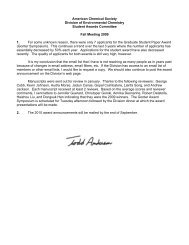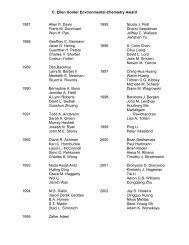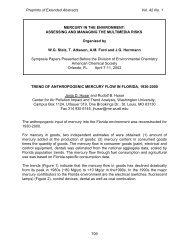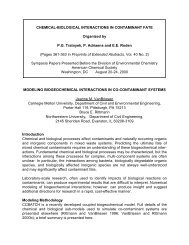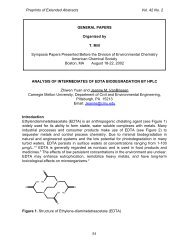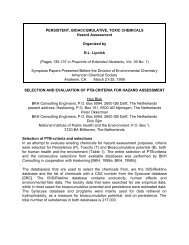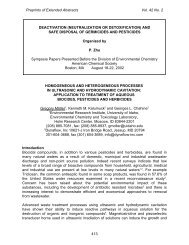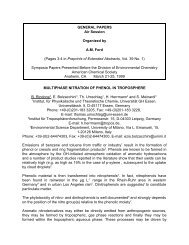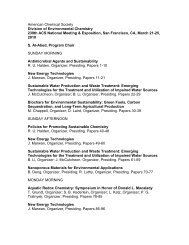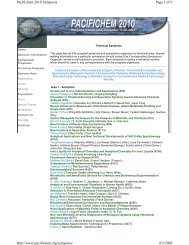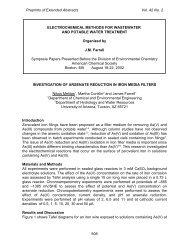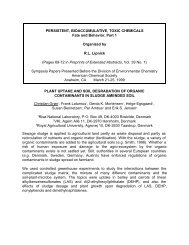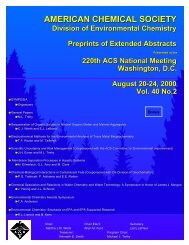paper 37 - ACS: Division of Environmental Chemistry
paper 37 - ACS: Division of Environmental Chemistry
paper 37 - ACS: Division of Environmental Chemistry
Create successful ePaper yourself
Turn your PDF publications into a flip-book with our unique Google optimized e-Paper software.
Preprints <strong>of</strong> Extended Abstracts Vol. 42 No. 2<br />
BIOGEOCHEMISTRY OF ORGANIC CONTAMINANTS<br />
IN AQUATIC ECOSYSTEMS:<br />
HONORING DR. JAMES G. QUINN<br />
Organized by<br />
J.W. Farrington and T.L. Wade<br />
Symposia Papers Presented Before the <strong>Division</strong> <strong>of</strong> <strong>Environmental</strong> <strong>Chemistry</strong><br />
American Chemical Society<br />
Boston, MA August 18-22, 2002<br />
RADIOCARBON CONTENT OF BLACK CARBON AND POLYCYCLIC<br />
AROMATIC HYDROCARBONS IN ENVIRONMENTAL SAMPLES<br />
Christopher M. Reddy* and Timothy I. Eglinton<br />
† Department <strong>of</strong> Marine <strong>Chemistry</strong> and Geochemistry,<br />
Woods Hole Oceanographic Institution, Woods Hole, MA 02543<br />
*E-mail address <strong>of</strong> lead author: creddy@whoi.edu<br />
Introduction<br />
Black carbon (BC) and polycyclic aromatic hydrocarbons (PAHs) are products <strong>of</strong> the<br />
incomplete combustion <strong>of</strong> fossil fuels, biomass and detrital organic matter 1-3 . Sediment<br />
and ice core records <strong>of</strong> BC and PAHs reveal that emissions <strong>of</strong> these species have<br />
dramatically increased during the past century 4-6 . The general trend in the Northern<br />
Hemisphere is a smooth increase beginning around 1880 to a maximum in the 1950s<br />
and 1960s and then a slow decrease until the present. These century-long records<br />
generally parallel society’s increasing reliance on fossil fuels for energy and<br />
transportation during the industrial revolution but also correspond to rapid population<br />
expansion and urbanization. Biomass burning associated with agricultural practices,<br />
heating, and land clearance for urban expansion would be expected to increase<br />
concomitantly. These relationships also would be expected to vary locally and<br />
regionally. Therefore it is not straightforward to establish which combustion sources<br />
have contributed to BC and PAHs through time. However, this information is necessary<br />
for developing temporal records so that current and future trends can be placed in the<br />
context <strong>of</strong> long-term variability and also to determine the success <strong>of</strong> source control<br />
measures.<br />
The 5730 y half-life <strong>of</strong> 14 C makes it ideal for discriminating combustion products derived<br />
from fossil fuels ( 14 C-free) versus those stemming from modern biomass (contemporary<br />
14 C). The potential <strong>of</strong> using 14 C to distinguish PAH sources has been recognized by<br />
several groups, however until recently, analytical constraints have limited this approach<br />
296
Preprints <strong>of</strong> Extended Abstracts Vol. 42 No. 2<br />
to the compound-class level 7,8 . Molecular-level 14 C measurements 9 <strong>of</strong> PAHs <strong>of</strong>fer the<br />
potential to quantify fossil fuel and biomass contributions to individual pyrogenic PAHs.<br />
Similar 14 C-based approaches for source apportioning BC in environmental matrices<br />
have been attempted but results vary as a function <strong>of</strong> the analytical methodology<br />
applied, implying methodological biases 10 .<br />
Here we present results from two independent analytical methods that determine the<br />
14 C abundance <strong>of</strong> PAHs and BC. Three Standard Reference Materials (SRMs) provided<br />
by the National Institute <strong>of</strong> Standards and Technology (NIST) were used to evaluate<br />
our analytical methods and to examine potential variability <strong>of</strong> 14 C abundance in BC and<br />
PAHs. These samples were chosen because they are well studied, homogeneous and<br />
commercially available. Here, we will first introduce the concept <strong>of</strong> molecular-level 14 C<br />
abundance measurements <strong>of</strong> PAHs for source apportionment. Second, we will use<br />
these 14 C measurements <strong>of</strong> the PAHs to provide a check on the validity <strong>of</strong> the BC<br />
method.<br />
Experimental Methods<br />
Extraction and purification<br />
The three SRMs investigated in this study were: SRM 1941a “Organics in Marine<br />
Sediment”, SRM 1944 “New York/New Jersey Waterway Sediment”, and SRM 1649a<br />
“Urban Dust”. Approximately 20 g to 200 g <strong>of</strong> each SRM were extracted with a mixture<br />
<strong>of</strong> dichloromethane (DCM)/methanol (93/7, volume fraction) in a Soxhlet apparatus for<br />
48 h or by pressurized fluid extraction (Dionex ASE-200) using DCM at 7000 kPa at<br />
100 ºC. The extract was reduced in volume and dried onto 10 g <strong>of</strong> pre-combusted<br />
quartz sand. This mixture was added to the top <strong>of</strong> a glass-column pressurized flash<br />
chromatography system packed with silica gel. The first fraction was eluted with 100%<br />
hexane and contained only aliphatic hydrocarbons. The second fraction was eluted<br />
with 50:50 hexane/toluene and contained the aromatic fraction, including PAHs and a<br />
complex, unresolved complex mixture (UCM). The remaining, polar material was<br />
collected using 100% methanol and saved for further studies. To separate the PAHs<br />
from the aromatic UCM in the second fraction, each sample was injected into a Hitachi<br />
L-6200 high performance liquid chromatograph (HPLC) with an ultraviolet detector (254<br />
nm) and separated into ring-size classes on a 30 cm x 7.8 mm Waters mBondapak NH2<br />
column. The mobile phase was a mixture <strong>of</strong> hexane/DCM (98/2, volume fraction) at a<br />
flow rate <strong>of</strong> 2 ml min -1 . Three fractions were collected at: 12 min to 24 min, 24 min to 41<br />
min, and 41 min to 60 mi. The 12 min to 24 min fraction contained the aromatic UCM<br />
and 2-ring PAHs (naphthalene and alkyl naphthalenes) and was not processed further.<br />
This step removed most <strong>of</strong> the UCM from each sample. The latter two fractions<br />
contained PAHs with 3 to 6 rings and were retained for single compound isolation.<br />
Preparative capillary gas chromatography (PCGC)<br />
Details on isolating individual organic compounds by PCGC are described in detail by<br />
Eglinton et al. 9 . Briefly, individual PAHs were isolated from the 3 to 6 ring fractions with<br />
repeated injections (~100) on a PCGC system until 25 µg to 250 µg <strong>of</strong> each individual<br />
PAH was obtained. PAHs were separated with a 60-m SGE BPX-5 fused silica column<br />
297
Preprints <strong>of</strong> Extended Abstracts Vol. 42 No. 2<br />
(60-m length; 0.53-mm diameter; 0.5 mm film thickness) and collected in cryogenically<br />
cooled glass u-tubes (0 °C). The isolated compounds were rinsed from the u-tubes with<br />
DCM and ~5% was saved to test for purity by injection on a GC employing a single inlet<br />
with dual capillary columns and dual flame ionization detectors (FIDs). The remaining<br />
material was transferred to pre-combusted quartz tubes (12-mm x 20-cm), where the<br />
solvent was evaporated under a stream <strong>of</strong> nitrogen and ~100 mg <strong>of</strong> copper oxide was<br />
added to each tube. The tubes were evacuated on a vacuum line and then combusted<br />
at 850 ºC for 5 h. The resulting carbon dioxide was isolated through a series <strong>of</strong> cold<br />
traps, quantified by manometry and then reduced to graphite 11 . Targets <strong>of</strong> the graphite<br />
were pressed and mounted on target wheels for 14 C analysis by accelerator mass<br />
spectrometry (AMS).<br />
BC analysis<br />
BC was isolated for 14 C analysis using a modified version <strong>of</strong> the method described by<br />
Gustafsson et al. 4,12 . This method operationally defines BC in environmental samples<br />
as the fraction <strong>of</strong> carbon remaining after thermal oxidation at <strong>37</strong>5 °C for 24 h (to<br />
remove labile organic carbon) and acidification (to remove inorganic carbon). Briefly,<br />
~200 mg <strong>of</strong> material was thinly spread onto 3 to 4 glass Petri dishes (10 cm diameter)<br />
and heated at <strong>37</strong>5 °C for 24 h in a programmable muffle furnace. The residue in each<br />
Petri dish was combined and then analyzed for 14 C analysis in a similar manner for that<br />
<strong>of</strong> sedimentary total organic carbon TOC 13 .<br />
Reporting radiocarbon results<br />
In this study, all 14 C measurements are expressed as fraction modern (fM). This term is<br />
defined by reference to the international standard for 14 C dating and is derived from the<br />
14 C/ 12 C ratio observed, relative to 0.95 times that <strong>of</strong> the contemporary standard for 14 C<br />
dating, SRM 4990B “Oxalic Acid” 14 . Each result is corrected for δ 13 C fractionation and<br />
for 14 C decay from the approximate date <strong>of</strong> sampling (or deposition) to the date <strong>of</strong> AMS<br />
analysis.<br />
For individual PAHs and BC, analytical repeatability for small-sample 14 C-AMS (25 µg<br />
to 300 µg <strong>of</strong> carbon) targets typically ranges between ± 1% to 2% <strong>of</strong> the fM, when<br />
determined for identical replicate samples and standards (determined on “modern”<br />
samples). In the case <strong>of</strong> small fM values reported for largely “fossil” samples, other<br />
factors such as counting statistics and internal AMS error figure more strongly into the<br />
reported 95% confidence level errors (typically ± 10 % to 30% <strong>of</strong> the fM.)<br />
Results and Discussion<br />
14 C in PAHs<br />
The PAHs 14 C abundance from each SRM is shown in Figure 1 and ranged from 0.01 to<br />
0.29; indicating that these samples contain PAHs that derive mainly from fossil fuels<br />
and/or the combustion <strong>of</strong> fossil fuels. The latter appears to be the more dominant<br />
source based on the (methyl phenanthrenes and anthracenes:phenanthrene ratios,<br />
which were 1, 1.5, and 0.5 in SRMs 1941a, 1944, and 1649a, respectively. (For<br />
comparison, Gustafsson and Gschwend 15 compiled the results from 20 studies and<br />
298
Preprints <strong>of</strong> Extended Abstracts Vol. 42 No. 2<br />
found that the approximate values for this ratio were 0.5 and 5 for pyrogenic and<br />
petrogenic sources, respectively). While difficult to actually quantify, the impact <strong>of</strong> trace<br />
quantities <strong>of</strong> UCM trapped with individual PAHs in this study is likely to be minimal<br />
since we have found that the UCM in these SRMs and other environmental samples is<br />
largely fossil in origin.<br />
Excluding perylene, which will be discussed in the next paragraph, PAHs in SRMs<br />
1941a and 1649a had similar 14 C contents with fM values from 0.0347 to 0.0864. SRM<br />
1944 had PAHs with the lowest and highest 14 C content (fM = 0.0144 to 0.143). These<br />
molecular data reveal the existence <strong>of</strong> isotopic heterogeneity both between samples<br />
and for individual PAHs within a single sample. Surprisingly, benzo[ghi]perylene had<br />
the largest contribution from modern carbon in all three SRMs. This finding conflicts<br />
with previous studies that have suggested that this PAH may be a marker for<br />
automobile emissions 16 . Individual PAHs exhibiting consistently lower radiocarbon<br />
contents are likely the best tracers <strong>of</strong> fossil fuel inputs. Chrysene yielded the lowest fM<br />
values in SRMs 1941a and 1944, while pyrene had the lowest 14 C content in SRM 1649a.<br />
The 14 C abundances <strong>of</strong> perylene in SRMs 1941a and 1944 reflect the multiple sources<br />
<strong>of</strong> this PAH to sediments. These include fallout or run<strong>of</strong>f from the combustion <strong>of</strong> organic<br />
matter, petroleum spills or seeps, and in situ diagenetic formation from aquatic and/or<br />
terrestrial precursors 17 . Perylene in SRM 1944 appears to be predominantly fossil-fuel<br />
derived as it has a 14 C abundance similar to the other PAHs. A natural in situ source <strong>of</strong><br />
perylene, however, is apparent in SRM 1941a, where its 14 C abundance is quite distinct<br />
from the other PAHs and closer to the bulk TOC (Figure 1).<br />
BC results<br />
The 14 C abundance <strong>of</strong> each SRM reveals that >90% <strong>of</strong> the BC is derived from the<br />
combustion <strong>of</strong> fossil fuels (Figure 1). These 14 C results are consistent with the urban<br />
settings <strong>of</strong> each SRM where fossil inputs, especially vehicular and industrial emissions,<br />
dominate. Such information will also be useful to parties interested in the different<br />
sorptive capabilities <strong>of</strong> BC (fossil vs. biomass derived) for planar, hydrophobic organic<br />
contaminants in marine sediments 4 .<br />
The comparison between data for the individual PAHs and BC isolated from the same<br />
suite <strong>of</strong> SRMs provides a unique opportunity to assess BC isolation methods and<br />
genetic relationships between these combustion products. Because the PAHs are<br />
isolated on a molecular basis, corresponding 14 C data for these species can be<br />
interpreted with a high degree <strong>of</strong> confidence. In contrast, much controversy persists<br />
concerning BC isolation methods that largely employ operationally defined methods,<br />
which are prone to greater uncertainty. For example, the extent to which non-BC<br />
components in an environmental matrix interfere with a given isolation method has<br />
been subject to considerable debate. With respect to the thermal method, “charring”<br />
reactions may potentially contribute to the residue during the isolation procedure 18 . In<br />
addition, some refractory biopolymeric materials (e.g., pollen) may survive the thermal<br />
299
Preprints <strong>of</strong> Extended Abstracts Vol. 42 No. 2<br />
treatment 4,12 . Both <strong>of</strong> these artifacts would manifest themselves in the 14 C<br />
measurements described here as artificially “modern” BC because <strong>of</strong> contributions from<br />
biomolecule-derived carbon to the BC residues. This in turn would lead to an apparent<br />
discrepancy between the fM values for the pyrogenic PAHs and BC. In each <strong>of</strong> the<br />
environmental SRMs studied, we find that the fM values for PAHs and BC are (a) similar<br />
and (b) significantly lower than that <strong>of</strong> the TOC (which is composed to a large extent <strong>of</strong><br />
recent biological detritus) implying that BC isolated and measured using the method<br />
described is not subject to these interferences (Figure 1). Overall, we believe these<br />
results validate the thermal oxidation approach as a means to accurately quantify and<br />
isotopically characterize BC in environmental matrices that have been moderately to<br />
severely impacted by combustion inputs. Its applicability to samples receiving minimum<br />
inputs is yet to be determined.<br />
References<br />
1. Goldberg, E. D. Black Carbon in the Environment; Wiley, New York, 1985.<br />
2. Kuhlbusch, T.A.J.; Crutzen, P.J. Global Biogeochem. Cycles 1995, 9, 491-501.<br />
3. Schmidt, M.W.; Noack, A.G. Global Biogeochem. Cycles 2000, 14, 777-793.<br />
4. Gustafsson, Ö.; Haghseta, F.; Chan, C.; MacFarlane J.; Gschwend, P.M. Env. Sci.<br />
Technol 1997, 31, 203-209.<br />
5. Hites R.A.; LaFlamme R.E.; Windsor J.G.; Farrington J.W.; Deuser W.G. Geochim.<br />
Cosmochim. Acta 1980, 44, 873-878.<br />
6. Kawamura, K.; Suzuki, I.; Fujii, Y.; Watanabe, O. Naturwissenschaften 1994, 81,<br />
502-505.<br />
7. Currie L.A.; Klouda G.A.; Vorhees K. Nucl. Instr. Meth. Phys. Res. 1984, B5,<br />
<strong>37</strong>1-<strong>37</strong>9.<br />
8. Lichtfouse, E.; Budzinski H.; Garrigues P.; Eglinton T.I. Org. Geochem. 1997, 26,<br />
353-359.<br />
9. Eglinton T.I.; Aluwihare L.I.; Bauer J.E.; Druffel E.R.M.; McNichol A.P. Anal. Chem.<br />
1996, 68, 904-912.<br />
10. Currie, L.A. et al. 2002, Journal <strong>of</strong> the NIST (in press).<br />
11. Pearson, A.; McNichol, A.P.; Schneider, R.J.; von Reden, K.F.; Zheng, Y.<br />
Radiocarbon 1998, 40, 61-76.<br />
12. Gustafsson, Ö.; Bucheli, T.D.; Kukulska, Z.; Andersson, M.; Largeau, C.; Rouzaud,<br />
J.N.; Reddy, C.M.; Eglinton, T.I. Global Biogeochem. Cycles 2001, 15, 881-890<br />
13. McNichol, A.P.; Osbourne, E.A.; Gagnon, A.R.; Fry, B.; Jones, G.A. Nucl. Instr.<br />
Meth. Phys. Res. 1994, B92, 162-165.<br />
14. Stuiver, M.; Polach, H.A. Radiocarbon 1977, 19, 355-363.<br />
15. Gustafsson, Ö.; Gscwhend, P.M. In Molecular Markers in <strong>Environmental</strong><br />
Geochemistry; Eganhouse, R.P., Ed.; American Chemical Society: Washington,<br />
DC, 1997; pp. 365-381.<br />
16. Currie, L.A.; Sheffield, A.E.; Riederer, G.E.; Gordon, G.E. Atmos. Environ. 1994,<br />
28, 1359-1369.<br />
17. Venkatesan, M.I. Marine Chem. 1988, 25, 1-27.<br />
18. Gelinas, Y., Prentice, K.M., Baldock, J.A., and Hedges, J.I. Env. Sci. Tech. 2001,<br />
35, 3519-3525.<br />
300
Preprints <strong>of</strong> Extended Abstracts Vol. 42 No. 2<br />
Figure 1. Radiocarbon content <strong>of</strong> PAHs, BC, and TOC in (a) SRM 1941a, (b) SRM<br />
1944, and (c) SRM 1649a. PAHs abbreviations are phenanthrene (PHE), fluoranthene<br />
(FLU), pyrene (PYR), benz [a]anthracene, chrysene (CHR), chrysene/triphenylene<br />
(CHR/TRI), benz<strong>of</strong>luoranthenes (BF), perylene (PER), benzo [ghi] perylene (BGP).<br />
301



